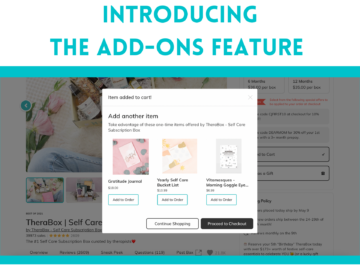Properly communicating with customers is one of the most important parts of running your business. As you onboard and interact with your subscribers, the customer experience becomes just as important as the product experience. Both can have equal impact on customer retention.
A big part of this is setting expectations: What promises or value propositions are you offering to your audience? How are you making these things clear?
Setting expectations for others – and reflecting on how well you’re doing that – can be very difficult. It’s called the curse of knowledge: the idea that because you’re so familiar with a subject, it makes perfect sense to you, and you (unconsciously) assume that it does for others as well. In other words, we can have difficulty understanding the customer experience because we have trouble seeing things from their perspective.
However, by following some best practices and simply taking the time to think through the customer experience, a savvy entrepreneur can navigate this. Today, we’ll discuss the following:
Basic Expectations

The first step is listing out what expectations you’re setting. This means the promises you’re making to your customers overtly, on your website and any other platforms. (Don’t include anything concrete that’s not listed on your site or otherwise locked in! If you do, you’re playing into the curse of knowledge again.)
These promises can include tangible and intangible facets of your business, relating both to your physical product and the service you provide. Consider these:
- Product offering: number of products, size, variety, quality, monetary value
- Price: signup cost, discounts, membership renewal cost
- Customer service expectations: contact, reply time, replacement/refund policies
- Operational expectations: shipping and delivery
Identifying expectations is as simple as listing them out under each category. Consider this example, then build out a list of your own:
- 6-8 Items
- Full-Size Products
- Ships on the 10th of the month. Subscriptions renew on the 20th of the month.
- Food and Bath/Body Products
Once you identify these standards, you’ll need to work backward to understand how a customer experiences, registers, and interprets them.
Product Offering

The product offering is your pitch – what you’re selling to your customers. It should be both compelling and novel, solve a real problem, and realistically depict what customers will receive.
When reflecting on your product offering, consider both the advertising medium and the messages you include. Keep a short list of things in mind:
- Is the packaging up-to-date and accurate?
- Do the products reflect, in number and quality, what’s been included in past boxes?
- Is there something special about the product offering? If so, is that highlighted in the written ad copy?
- Are there special instructions for customers, and if so, are they clear?
Remember, however, that you can balance these best practices with aesthetic appeal in your advertising. Making your products look good should still be a goal! But make sure not to distort your product offering (for example, by displaying your subscription box overflowing with more products than the box actually includes). This could backfire and upset customers who expect to receive exactly what’s depicted.
Pricing Your Box

Price theory can be a complex and data-rich topic. For the purpose of this discussion, however, it’s quite simple. It comes down to clarity, consistency, and transparency. For example, a surprising charge or otherwise confusing cost can be an extremely frustrating experience for the consumer. Ask yourself:
- Is my price clear on my website? Is it on my homepage, product page, checkout, and confirmation pages?
- Does the confirmation email clearly state price and renewal price?
- If the customer clicked through an ad or special promotion, does the coupon or special deal automatically apply to the order? If not, are the instructions clear on both the ad and landing page?
- Are charges for recurring subscriptions listed upon checkout and confirmation?
- Do you list subscriptions or other recurring prices in customer accounts?
- Are your prices, renewal dates, and renewal amounts listed in your FAQ or pricing page on your website?
Keeping payments clear and transparent help you to avoid confusing or upsetting customers. That doesn’t mean you always need to pin down specific dates – you can state that you “renew accounts around the 25th of the month,” for example, if you want flexibility with rebilling. This kind of policy is helpful if a box gets delayed and you don’t want to renew a customer’s subscription until it arrives.
Read more: This strategy of allowing yourself flexibility while remaining clear can also be used in operational communications. Check out our guide to shipping and rebilling.
Customer Service and Operations
![]()
While customer service expectations aren’t necessarily listed in your ads, they become especially important when you have a recurring customer base, because you’re often communicating with these same customers month after month. It’s important to provide a resource that customers can use individually or for reference in discussions with your employees. Consider these few points:
- Are operational notes, such as shipping time, listed upon checkout or in the confirmation email? You have two options here: you can either give yourself some flexibility at the risk of sounding vague (e.g. “Ships mid-month”), or you can update your shipping details monthly (e.g. “Order by 9/15 to receive the October box, which will go out 10/2”). This option allows you to be super clear with subscribers, at the cost of a few more minutes each month.
- Build out an FAQ for customers. This should include answers to even the most obvious questions (“How many products are there?” or “What is this service?”) and cover all parts of your business: shipping, billing, product, customer support contact and policies, etc.
- Consider leveraging the use of a help center like Zendesk. This is a searchable, flexible support community where customers can research answers, leave comments, and discuss topics together.
- Provide customers with self-service tools to save you time and put customers in control. For example, by building out an Address section in your customer’s dashboard, you can remove a normally demanding feature of customer service and allow customers to update their own profile. This is useful for payment information and subscription status as well.
Better Expectations means Better Customers
Rinse and repeat the cycle of evaluating your expectations as often as possible. Remember that communication is key to an ongoing relationship. The only surprise your customers seek is the joy of opening their boxes each month!



